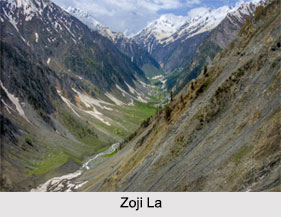 Zoji La is a mountain pass of high altitude and it is paradise of trekkers and bikers after Khardongla Pass. ZojiLa is located on the Srinagar-Leh National Highway 1D in the western section of the Himalayan Mountain Range.
Zoji La is a mountain pass of high altitude and it is paradise of trekkers and bikers after Khardongla Pass. ZojiLa is located on the Srinagar-Leh National Highway 1D in the western section of the Himalayan Mountain Range.
Location of Zoji La
Zoji La is located in Jammu and Kashmir. It is exactly situated on the Indian National Highway 1D between Srinagar in Srinagar District of Jammu and Kashmir and Leh District of Jammu and Kashmir in the western section of the Himalayan Mountain Range.
Naming of Zoji La
The word "Zojila Pass" is not an Indian term. The correct English translation of Zoji La is Zoji Pass or simply Zojila. The usage of the word "La" can also be seen in the Khardung La, Fotu La, Namika La and Pensi La and many other passes in Zanskar and Pir Panjal Range. In modern-day North Indian languages, `La` and `Darra` are both used interchangeably to mean a mountain pass.
History of Zoji La
Zoji La came into existence from the historical era of Silk Route. But during the Indo-Pakistani War, Zoji La was seized by Pakistani Army in the year 1948 in their campaign to capture Ladakh and the entire Kashmir. Zoji La was recaptured by Indian Armed Forces on 1st November in an assault codenamed Operation "Bison", which achieved success primarily due to the use of tanks.
Geography of Zoji La
Zoji La is about 9 km from Sonamarg in Jammu and Kashmir and provides a vital link between Ladakh and Kashmir Valley. Zoji La runs at an elevation of approximately 3,528 metres and is the second highest pass after Fotu La on the Srinagar-Leh National Highway.
Closing of Zoji La
Zoji La is open to public. Zoji La is often closed during winter season, though the Border Roads Organisation (BRO) is working to extend traffic to most parts of the year. The Beacon Force unit of the BRO is responsible for clearing and maintenance of the road during winter.
Visiting Information
Zoji La is easily accessible from Kashmir, Budgam District, Srinagar, Ganderbal District and Kargil. It is easily to travel via Sonamarg in Jammu and Kashmir.
Related Articles
Ladakh
Jammu and Kashmir
Culture of Jammu and Kashmir
Adventure Sports in Jammu & Kashmir
Srinagar District
Srinagar
Tourism In Srinagar



















